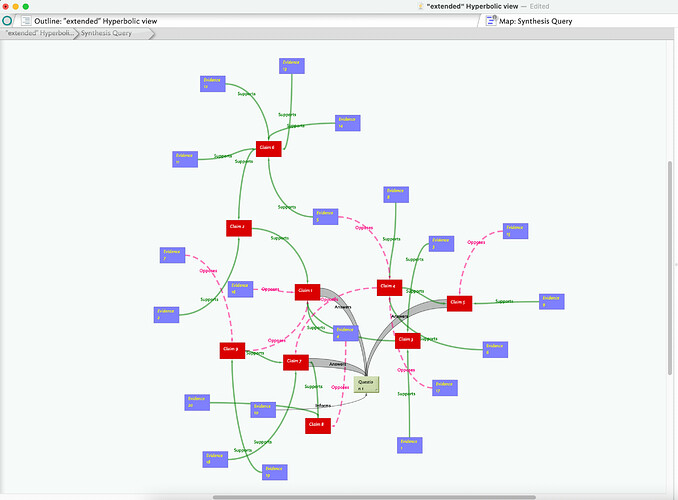I’m not sure how to understand your question, so excuse me if my answer isn’t precise. I will try to describe the “what, why, and how” of this TB project.
I’m studying for my second master’s degree, and I’m thinking about doing a Ph.D. later. I’ve learned the hard way how important is well written (systematic) literature review for later research, so I’m now trying to set up a system that will help me to do it. I’m trying to implement Joel Chan’s research on Discourse Graphs (short theoretical write-up can be found here and here).
In short:
Discourse graphs are an information model for bodies of knowledge that emphasize discourse moves (such as questions, claims, and evidence), and relations (such as support or opposition). (…)
this information model can be seamlessly integrated into a networked note-taking workflow for literature reviewing and writing, in such a way that authoring a formal discourse graph becomes a byproduct of (and directly enhances) joyful, intrinsically and immediately beneficial tasks like notetaking and outlining, and collaboration. Source
Joel Chan is implementing his work in Roam Research, but IMO Tinderbox is much more powerful and better suited to this job (I hope so!). So how does it work? Most books and research papers have a (hypo)thesis that they tried to prove/disprove/explain (I don’t want to get into the philosophy of science here). That’s the main Claim(s), the rest of the Claims just try to support it by providing pieces of Evidence (maybe it would be better to call them “Data” or “Context”). One day, one of those pieces of Evidence will be contradictory to our current state of knowledge/beliefs or will have some kind of connection to other Evidence/Claim that we found in another article ---- and we ask Question. The goal of the “extended” Hyperbolic view is to make the synthesis process better.
The one thing that I still haven’t figured out is how to generate a “Synthesis Query” report - a page of text where all queried notes and their connections form a linear whole." extended" Hyperbolic view shown below helps in the synthesis process, but after playing with it (deleting notes, deleting and creating new links, and so on), I want to “print out” the results of my work in form of above mentioned “Synthesis Query” report. How do I imagine it to look like? Let me use an example. Let’s assume that my question is called “Question 1”, and I have three claims that are its answer - Claim 7, Claim 5, and Claim 1. For reasons of simplicity let’s focus only on Claims 7 and 5. (there is an outline shown below, as also a map view for reference)
The logic behind it:
I’m thinking about writing a template for “Synthesis Query” agent, but I’m not sure where and how to get started, the only thing I’m pretty sure it that I will have to write a looooot of loops to gather all the required information to show them later in a single note.
What I’m trying to achieve here, is it possible at all? Or maybe there are other, more elegant ways to do it? I will be grateful for any form of feedback. It would mean a lot to me.
Thanks for reading
Arek
 ). Aliases collected by an agent called “Synthesis Query” get their original notes’ links restored, so notes that are linked to the “focus” note (in my case it’s a note with pQuestion $Prototype) can be easily traced. Compared with the Hyperbolic view, Map view of queried notes shows also links that don’t create the shortest possible path to the “focus” note.
). Aliases collected by an agent called “Synthesis Query” get their original notes’ links restored, so notes that are linked to the “focus” note (in my case it’s a note with pQuestion $Prototype) can be easily traced. Compared with the Hyperbolic view, Map view of queried notes shows also links that don’t create the shortest possible path to the “focus” note.



